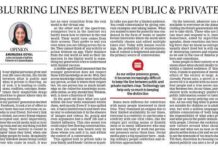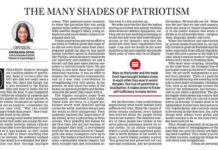Who does the city really belong to? Those who are born there, those who made it their home, those who migrate there to work and build a life, or those who work for it?
Recently, I spent a few weekend mornings collaborating with The Ugly Indian team in cleaning a major traffic junction and footpaths close to my home in Bengaluru. Besides the aesthetic and hygienic changes around me, it made me meet fellow citymates who care enough to get their hands dirty on a morning they could have lazed around. As novices, we learnt to hold paint brushes, struggled to draw a straight line, but eventually learnt to keep the hand steady. We played with different colours as we painted the pillars and sidewalks once they were cleaned.

Paurkarmikas or sanitation workers created some beautiful rangolis on the traffic island that was filled with debris and garbage just three days earlier and was now like a small garden where you could meet people as the city traffic buzzed past. A sense of accomplishment, relief, confidence, joy and can-do flourished as we exchanged names and greetings.
I ended up meeting old friends, neighbours I knew but never spoke to, neighbours I did not know, the wonderful team of the Bruhat Bengaluru Mahanagara Palike and volunteers who had come from other parts of the city to clean my area. I stood there with a sense of gratitude for all the volunteers, a sense of ownership for my neighbourhood and my city, as well as a shared sense of belongingness to the place and the people. After my first participation, I shared a short video in my neighbourhood group and the next Sunday many more showed up.
The workers from BBMP and other authorities like the Bangalore Metro Rail Corporation did the heavy lifting in clearing the garbage, fixing the footpaths, and dealing with hanging wires. We primarily lent a helping hand, mostly by cleaning and painting. Team effort, as the corporate world would call it. I would say it was a process of owning the place, reclaiming it from the garbage dump that tends to keep increasing like the Raktabeeja asura.
Read – Walkability of Our Cities
The whole exercise made me think about being angry at the deteriorating condition of our civic spaces. We do not think twice before posting those pictures on social media. In casual conversations, we are always ready to blame the civic authorities. But how many times do we try to engage with them to get the work going? Isn’t our apathy, and in a subtle way our acceptance to live with filth, an input for those who let it be?
People behind civic authorities are also human. They may be dealing with a hierarchy of priorities and choose to attend to those where the citizens are actively engaged. Think about two toddlers: one of them making an effort to get up and walk, falling but getting up again, and the other simply expecting someone to lend a hand and make him walk. Which one are we more likely to help? The first one. Every religion tells us that god helps those who help themselves. So it is in our social setting.
The garbage piles are unprecedented, with every home delivery, especially of food, adding to it. The companies and consumers generating these piles take near-zero responsibility to reduce this waste or dispose it responsibly. Mindless consumption gives us a false sense of well-being while we are creating heaps of garbage that create a circle of unhygienic, unaesthetic surroundings, bringing down our overall well-being. It’s time the Japanese SpoGomi became our chosen sport.
Big cities have a migrant population that comes primarily for work. It takes years to make a city your new home and to be emotionally connected with it enough to care. Corporate jobs come with their own demands on time, which does not allow one to engage socially with the surroundings. However, if this is the surrounding that one has chosen to be a part of, one must make some effort to make it better, at least by not making it worse.
The deep trench between citizens and civic authorities also needs to be narrowed and bridged with periodic events that bring them together in an informal setting allowing a free flow of information, expectations, plans, and challenges. Most public events see a demarcation between public servants who tend to be isolated, surrounded by their own teams.
Our cities are designed to not allow serendipitous interactions between authorities and common citizens. So, we need to create those opportunities through public events where no formal hierarchies are followed and everyone is simply a fellow resident. Creative and innovative ideas for cleaning up will come at the intersection of public service and active citizen participation. It is easy to clean it once, but sustaining it is the bigger challenge, somewhat like weight loss.
“A city belongs to those who care for it,” said an author who wrote a book on Delhi. His words stayed with me.
First published in The New Indian Express on Nov 02, 2025.









The sad part is people want to keep their Homes clean and tidy but do not mind throwing the garbage outside on the road from their Homes
Appreciate your initiative and wish a lot of people actively participate in community service to keep their city clean
Beautifully captured and genuinely put across. I am sharing your piece amongst friends to spread the message. We need to develop a deeper sense of care and responsibility to our cities and towns, of we genuinely want to be seen as a developed society.